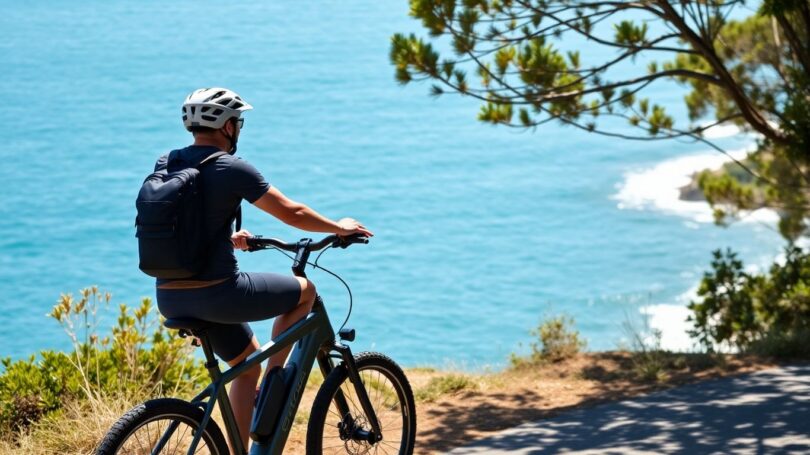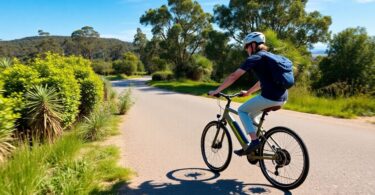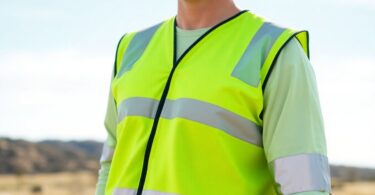So, you’ve got yourself an e-bike in Australia, or you’re thinking about getting one. That’s awesome! They’re a great way to get around, whether it’s for your daily commute or just a weekend cruise. But like any vehicle, riding one safely is super important. We’re talking about staying safe on your e-bike, understanding the rules, and just generally being a smart rider. It’s not rocket science, but a few pointers can make a big difference to your ride.
Key Takeaways
- Make sure your e-bike meets Australian safety standards. Look for compliance details, especially if buying now, to avoid issues later.
- Always wear a helmet and make yourself visible with bright or reflective clothing. Good footwear helps too.
- E-bikes feel different – they’re faster and heavier. Practice smooth acceleration and braking, and get used to how it handles.
- Know your local traffic rules for e-bikes. Ride predictably and signal to others so they know what you’re doing.
- Before you ride, give your e-bike a quick once-over. Check tyres, brakes, and battery. Regular checks keep things running smoothly and safely.
Understanding E-bike Compliance In Australia
Navigating New Safety Standards
Things are changing with e-bikes in Australia, especially in places like NSW. From early 2025, all new e-bikes and their batteries need to meet specific safety standards. By 2026, you’ll even see certification labels on them. This is a big deal because it means the gear you buy has been checked for safety. It’s not just about avoiding trouble like fines or having your bike taken away; it’s about making sure the bike won’t catch fire or break down unexpectedly. These new rules are designed to make riding safer for everyone. It’s worth checking out the latest updates from Transport for NSW to stay in the loop.
Legal Classifications For E-bikes
So, what actually makes an e-bike legal here? In most Australian states, an e-bike needs to meet certain criteria to be treated like a regular bicycle. Generally, this means the motor can’t be more powerful than 500 watts, and it should only assist you when you’re pedalling. The assistance has to stop when you hit 25 km/h. Some bikes might have a throttle, but this is usually only allowed for a little boost when you start off, up to about 6 km/h. If your bike has more power or a throttle that works at higher speeds without pedalling, it might be classed as a motor vehicle. That means you’d need registration, a licence, and insurance, and you couldn’t ride it on bike paths or many roads.
Here’s a quick rundown of common classifications:
- Power-Assisted Pedal Cycle: Max 200W, pedals must be primary drive, assistance cuts off at 25 km/h.
- EPAC (Electrically Power-Assisted Cycle) / Pedelec: Up to 500W, motor assists pedalling, cuts off at 25 km/h. Must comply with standards like AS 15194:2016.
- Motor Vehicle: Exceeds 500W or has a throttle that works above 6 km/h without pedalling. Requires registration, licence, and insurance.
Avoiding Non-Compliant Purchases
Buying an e-bike can be exciting, but it’s easy to end up with something that doesn’t meet Australian standards. Sometimes sellers might not even know if their bikes are compliant. Always ask for proof of Australian compliance before you buy. If a seller can’t provide this, it’s a good idea to look elsewhere. You want to be sure that the bike you’re purchasing is legal to ride on our paths and roads. It’s also wise to steer clear of modification kits that promise to boost your bike’s power beyond the legal limits. These can void warranties, make your bike illegal, and, most importantly, create safety hazards. Choosing a reputable dealer who understands Australian compliance is your best bet.
Essential Protective Gear For E-bike Riders
Alright, let’s talk about kitting yourself out properly before you hop on your e-bike. It might seem obvious, but the gear you wear makes a massive difference to your safety, especially with the extra oomph these bikes have.
The Importance Of Helmets
Look, this is non-negotiable. Wearing a helmet that fits well and meets Australian safety standards (AS/NZS 2063) is the single most important thing you can do. E-bikes can get you up to speed pretty quickly, and a fall can happen in a blink. A good helmet can protect your head from serious injury. Don’t just grab any old thing; make sure it’s snug, doesn’t wobble around, and you can actually see out of it properly. It should sit level on your head, not tilted back or forward.
Visibility Through Reflective Clothing
Being seen is just as important as seeing. When you’re out on your e-bike, especially during dawn, dusk, or in dodgy weather, other road users need to spot you. This means thinking about your clothing. Bright colours are a good start, but reflective elements are where it’s at. Think jackets, vests, or even just reflective strips you can add to your backpack or shoes. It doesn’t have to be flashy; anything that bounces light back at headlights will make you much more visible.
Choosing Appropriate Footwear
Your feet are your connection to the pedals, and they can also be your emergency brake if you need to put a foot down. So, ditch the thongs or flimsy sandals. You want shoes that offer good grip on the pedals and provide some protection for your feet. Sturdy trainers or cycling-specific shoes are a solid choice. They’ll help keep your feet from slipping off, especially if things get a bit wet or bumpy, and offer a bit more support than your average casual shoe.
Riding an e-bike can feel deceptively simple, but the added speed and weight mean you need to be prepared for unexpected situations. Having the right gear isn’t just about comfort; it’s about having a better chance of walking away from a mishap without serious injury. Think of it as an investment in your own well-being on the road.
Mastering E-bike Handling And Control
Adapting To Extra Speed And Weight
E-bikes are a bit different from your regular pushy. That motor adds a fair bit of oomph, meaning you’ll get up to speed quicker and can carry more momentum. It also means the bike feels heavier, especially when you’re trying to manoeuvre it at low speeds or when you’re stopped. You’ll need to get used to how much faster things happen and how the bike feels with that extra weight. Think about how you’d handle a heavier bike; you’ll need a bit more space to stop and turn, and you’ll want to be smoother with your movements. It’s not a race, so take your time getting a feel for it.
Smooth Acceleration And Braking Techniques
Getting the hang of the throttle and brakes is key. Instead of just whacking the throttle open, try easing into it. This gives you more control and stops the bike from feeling jerky. The same goes for braking. Don’t just slam on the brakes; apply them gradually. This helps you stop more smoothly and stops the wheels from locking up, especially if the road’s a bit slick.
Here’s a quick rundown on smooth stopping:
- Anticipate: Look ahead and see where you need to slow down or stop.
- Feather the Brakes: Apply gentle pressure first, then increase it as needed.
- Use Both Brakes: Engage both the front and rear brakes for better stopping power and control.
- Body Position: Stay relaxed and keep your weight balanced.
Cornering And Balance On An E-bike
Cornering on an e-bike feels a bit different because of the extra weight. You’ll want to lean into turns a little more, but not too much. Keep your eyes looking through the turn, not just at where you’re going to turn. It helps you keep your balance. If you’re going too fast, it’s better to slow down before the corner rather than trying to brake hard in the middle of it. Remember, a bit of practice on quieter roads will make a big difference.
Starting an e-bike on a hill can feel a bit daunting at first, but it’s all about getting a feel for how the motor works with your pedalling. Using a lower assist level and starting with a gentle pedal stroke can make a world of difference. Don’t be afraid to use your gears to help you get moving, just like you would on a regular bike. It’s about finding that sweet spot where you’re not fighting the bike, and it’s not fighting you.
Navigating Australian Roads And Paths

Understanding Local Traffic Laws
Every state and territory in Australia has its own set of rules for e-bikes, and it’s your job to know them. These aren’t just suggestions; they’re laws designed to keep everyone safe. Things like where you’re allowed to ride (footpaths, bike lanes, roads), speed limits, and whether you need a helmet can differ. For instance, in some places, e-bikes might be treated like regular bicycles, while in others, they could have specific classifications. Always check the specific regulations for your local area before you head out. It’s not worth the risk of a fine or, worse, an accident because you didn’t know the rules.
Here’s a quick rundown of common areas to look into:
- Speed Limits: Know the maximum speed allowed for e-bikes in different zones.
- Path Usage: Understand where you can and can’t ride – footpaths, cycle paths, and roads all have different rules.
- Age Restrictions: Some areas might have minimum age requirements for riding e-bikes.
- Equipment Requirements: Check if specific lights, bells, or reflectors are mandatory.
Ignorance of the law isn’t a defence. Taking a few minutes to look up your local road rules can save you a lot of hassle and keep you safer on your rides.
Predictable Riding For Safety
Being predictable on your e-bike is like speaking a language that other road users understand. When you ride predictably, you make it easier for drivers, pedestrians, and other cyclists to anticipate what you’re going to do next. This means avoiding sudden swerving, signalling your intentions clearly before you turn or change lanes, and maintaining a consistent speed where possible. Think about it: if a car suddenly veers into your lane without warning, it’s startling and dangerous. The same applies when you’re on your e-bike. Stick to your line, use your indicators, and try not to weave in and out of traffic or parked cars unexpectedly. This calm, consistent approach builds trust and reduces the chances of a misunderstanding that could lead to a mishap.
Communicating With Other Road Users
Good communication isn’t just about talking; it’s about making yourself known and understood when you’re out on your e-bike. This goes beyond just signalling. A friendly wave to a pedestrian you’re passing on a shared path, a nod to a fellow cyclist, or making eye contact with a driver at an intersection can go a long way. These small gestures acknowledge that you’re sharing the space and can help diffuse potential tension. When you’re approaching others, especially from behind, a polite "hello" or "on your right" can alert them to your presence without startling them. Similarly, if you need to slow down or stop, try to give a clear hand signal or verbally let people know. Being aware of your surroundings and making these simple connections helps create a more harmonious and safer environment for everyone.
Pre-Ride Checks And Maintenance

Inspecting Tyres And Brakes
Before you head out, give your tyres and brakes a quick once-over. It might seem like a hassle, but it’s a really good habit to get into. Check your tyre pressure – you want them firm but not rock hard. Squishy tyres can make handling a bit dodgy, especially if you’re carrying extra weight or going faster than usual. Then, give your brakes a squeeze. Do they feel firm? Do they stop the wheels effectively? If they feel spongy or weak, it’s time to look into them. A quick visual check for any obvious damage to the tyres or brake pads is also a smart move.
Battery Charge And Throttle Response
Your e-bike’s battery is its heart, so make sure it’s ready to go. Check the charge level – you don’t want to run out of juice halfway to your destination. If you’re planning a longer ride, it’s worth knowing your battery’s range. Also, when you first power up, give the throttle a gentle twist (if your bike has one) or start pedalling to feel the assist. You want a smooth, predictable response. Any weird noises or a sudden, jerky surge of power? That’s a sign something might need a look.
Regular Equipment Checks
Beyond the tyres, brakes, and battery, there are a few other bits and pieces to keep an eye on. Make sure your lights are working, especially if you’re riding in low light conditions or at night. Check that your chain looks okay – not too dry or rusty. Give your handlebars a wiggle to ensure they’re tight and secure. It’s also a good idea to have a basic toolkit with you, just in case. Things like a multi-tool, a spare tube, and a pump can be lifesavers when you’re out and about.
A little bit of regular attention can save you a lot of trouble down the track. Think of it like checking the oil in your car – it’s not exciting, but it keeps everything running smoothly and safely.
Here’s a quick checklist to run through:
- Tyres: Check pressure and look for wear or damage.
- Brakes: Test for firm feel and effective stopping power.
- Battery: Confirm sufficient charge for your planned ride.
- Lights: Ensure front and rear lights are functional.
- Chain: Inspect for lubrication and signs of wear.
- Handlebars/Seat: Confirm they are securely fastened.
Riding Safely In Diverse Conditions
Awareness Of Weather Impacts
Riding your e-bike when the weather’s not playing nice can be a bit of a challenge, but it’s totally doable if you’re prepared. Rain, for instance, can make roads slicker than a greased watermelon, and that means your stopping distances get way longer. You’ve got to be thinking ahead, way more than you would on a sunny day. And don’t forget about the heat – batteries don’t love getting too hot, and neither do you. Staying hydrated and finding shade when you can is a good shout.
Adjusting Riding Techniques For Conditions
When it’s wet, slow down. Seriously, cut your speed back by a good chunk, maybe 25-40% less than you’d normally go. Start braking earlier, and use both your front and back brakes gently, but lean a bit more on the rear one to avoid locking up the front wheel. Sudden moves are a big no-no; they can send you skidding. For hot weather, try not to push the motor too hard. Use lower assist levels, take breaks in the shade, and keep yourself topped up with water. It’s all about being smooth and predictable.
Prioritising Safety Over Speed
- Always have your lights on, even if it’s just overcast. Bright colours and reflective gear are your best mates in low visibility.
- Check your tyres before you head out. Make sure they’ve got enough tread and are pumped up right for the conditions.
- Listen to your bike and your body. If the battery’s getting too hot or you’re feeling drained, it’s time to pull over or call it a day.
When the weather turns, your usual riding habits might need a rethink. It’s better to arrive a bit later, or even not at all, than to risk a spill. Think about alternative transport if conditions are really gnarly.
After riding in the wet, give your bike a good clean and dry. Make sure the chain is lubed up properly – use a wet lube if it’s been raining a lot. And give those brakes and tyres a once-over. It’s a bit of extra work, but it keeps your e-bike running sweet and stops rust from taking hold.
Ride On, Safely!
So, there you have it. E-bikes are a ripper way to get around Australia, whether you’re nipping to the shops or heading out for a weekend cruise. But like anything with a bit of zip, you’ve gotta be smart about it. Knowing the rules, keeping your bike in good nick, and always wearing that helmet are the big ones. Don’t forget about staying visible, especially when it’s getting dark. It’s not about being a scaredy-cat, it’s just about being sensible so you can keep enjoying your rides without any dramas. Stick to these tips, and you’ll be cruising with confidence, knowing you’re doing your bit to stay safe on our roads and paths. Happy riding!
Frequently Asked Questions
What do I need to know about e-bike rules in Australia?
Basically, e-bikes need to meet certain safety standards. From 2025, all e-bikes and their batteries have to be safe, and by 2026, they’ll need special labels showing they’re okay. It’s important to check if your bike is legal, especially if you bought it recently, so you don’t end up with something that’s not allowed or even unsafe. The rules are there to keep everyone, including you, safe.
Is it really that different riding an e-bike compared to a normal bike?
Yeah, it can be! E-bikes are quicker and heavier because of the motor and battery. This means you need to get used to how they speed up and slow down. Braking feels a bit different, and you need to be extra careful when turning. It’s not just like riding a regular bike, so taking it easy at first is a smart move.
What safety gear should I always wear when riding my e-bike?
A helmet is a must-have, no exceptions! It’s the most important thing to protect your head if you fall. Also, wearing bright or reflective clothes makes you much easier for drivers and others to see, especially when it’s getting dark or the weather’s not great. Good shoes that cover your feet are important too, not just thongs.
How can I be safe when riding my e-bike on Australian roads?
First off, know the local traffic rules for bikes and e-bikes – they’re different everywhere! Always ride in a way that other people can guess what you’re going to do, like signalling before you turn. Make sure drivers and pedestrians can see you by staying visible and maybe using your bell. Being predictable and aware of everyone around you is key to staying safe.
Why should I check my e-bike before I ride it?
Just like checking your car before a trip, it’s smart to give your e-bike a quick look-over. Make sure your tyres are pumped up and your brakes work well. Check that the battery is charged enough for your ride and that the motor kicks in smoothly when you use the throttle or pedals. A quick check can stop problems before they happen.
What if the weather is bad? Can I still ride my e-bike safely?
Riding in rain, wind, or even heat needs extra care. Wet roads make it harder to stop, and strong winds can push you around. You might need to slow down, brake earlier, and be more careful when turning. Always check the weather before you go and be prepared. If it looks too risky, it’s better to find another way to get around than to put yourself in danger.








